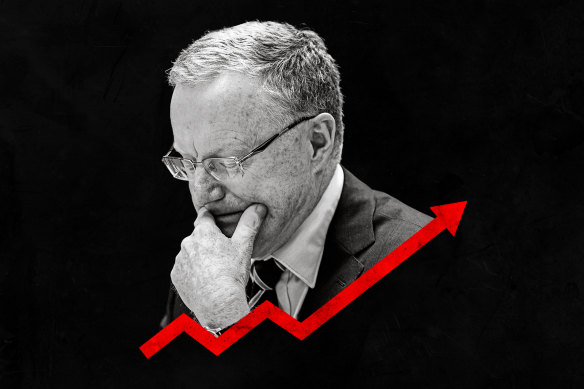I have a vision board in my bedroom of what I’d like my life to look like: a reminder to aim for 10,000 steps a day, photos of people I admire – some of whom may be startled to find themselves there – and sappy quotes about finding “the one”.
It’s part of a practice called “manifestation”, which some people swear by: making your dreams come true by mentally visualising them. So far this year I’ve lost my fitness watch, and I’m yet to turn into my favourite YouTuber. But there’s a recent addition to my board: lower inflation.

Credit: Alex Ellinghausen/Stephen Kiprillis
What if I told you the price increases you’ve been seeing could be slowed down – through manifestation? You might be shaking your head, but economists believe in it. They don’t call it manifestation, of course, or we’d start to think their job was some unreliable exercise in predicting human behaviour.
But inflation is fuelled by people’s belief in it – and more specifically, the expectation of where it’s heading. Everyone wants to get in when things are cheap. If you expect prices to rise in the future, you tend to push forward your purchases. The problem is when lots of people are thinking the same thing.
As you know, prices are determined by demand and supply. When there’s a lot of demand for something – say masks during a pandemic – the price tends to rise. And if you expect prices to keep rising, you’re going to stock up even more and, yes, push prices up even more.
Loading
Sometimes, our incentives are shaped by government intervention. More than 100,000 Aussies decided to build homes during the pandemic after a grant program temporarily lowered the cost. They mightn’t all have been in such a rush if they thought low prices would continue, but with a clear cut-off date, there was a surge in demand – not just here but in countries around the world. And that led to a surge in the cost of building materials.
On the flip side, if you think prices will decline in future, you’re more likely to hold off on spending, so you can snag a bargain later. When demand falls, the item becomes less scarce, and the price falls. It’s a self-fulfilling prophecy.
Now, that’s a simplification and there are several factors behind inflation – many out of our control. Remember, it’s not just demand, but supply that affects the price of things. Countries may go to war, leading to shortages in the things they’d usually produce. A virus can take millions of workers out of action and natural disasters might wipe out farms. The less of something there is to go around, the more expensive it tends to become.
Stay connected with us on social media platform for instant update click here to join our Twitter, & Facebook
We are now on Telegram. Click here to join our channel (@TechiUpdate) and stay updated with the latest Technology headlines.
For all the latest Business News Click Here
For the latest news and updates, follow us on Google News.
